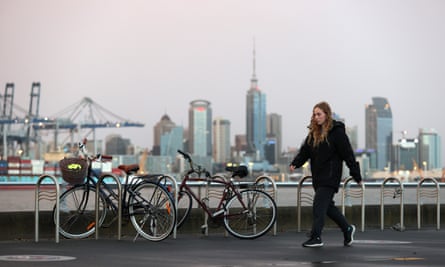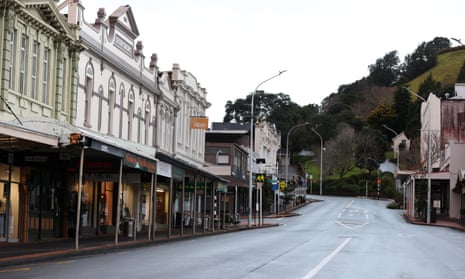As epidemiologist Michael Baker scrolled through a growing list of New Zealand’s Covid-exposed locations, “my heart just sank,” he says.
Bars, nightclubs, churches, schools, restaurants and hospitals – the bullet points were an infectious disease expert’s nightmare. “Virtually every high risk, indoor environment was on that list.”
It was two days into New Zealand’s outbreak. The country, long a pandemic success story, now faces its biggest hurdle since the pandemic began. Over the past two months, New Zealand has looked on as elimination success-stories across the Asia-Pacific region battle the Delta variant. Hong Kong, Australia, China, Taiwan and Singapore – all had achieved elimination or close to it. Delta arrived to them all, and many struggled to contain it.
“Now, New Zealand’s added to the list,” says Baker, a professor and leading communicator of the country’s pandemic response. The country was put into a nationwide lockdown on Tuesday night, after a single case was detected earlier in the day. Over the following days, the country’s contact tracers and testers have been in a race against time to find the origin of the virus in-country, and to track how far it spread before detection. By Friday, case numbers had risen to 31, spread across three regions, including two of New Zealand’s most populous cities. Health officials have published a steadily-expanding list of more than 140 locations infected people may have visited.

On Friday, Ardern confirmed that the entire country would remain at its highest level of lockdown until at least Tuesday. With just 23% of New Zealand’s adult population fully vaccinated, Delta has the potential to rip through the country. New Zealand’s pandemic response has been world-beating in the past. Now, both its own citizens and other countries will be watching to see if it can overcome the latest threat.
‘Obvious weak spots’
New Zealand’s pandemic response is “amongst the tightest of any country – certainly of any of the liberal democracies – but it’s still got these obvious weak spots,” Baker says.
Its most obvious weakness is low vaccination rates. Around a third of all New Zealanders have had one shot, and 19% have had both. Among those unvaccinated are many essential workers: while healthcare and border workers were prioritised for vaccines, those staffing supermarkets and pharmacies were not. “That’s 10 to 15% of the population are not locked down at home, they’re not in home quarantine, they’re out and about, keeping the country working,” Baker says.
Some of New Zealand’s public health measures were also designed at the outset of the pandemic, when the focus was on surface and droplet transmission. Over time, scientific consensus has shifted – to acknowledge, for example, that Covid-19 can be airborne and linger, infectious, in the air of indoor environments.
Many countries have adapted to those findings gradually over the past year – with some shifting to a culture of near-universal mask wearing, or addressing challenges like indoor ventilation. But with more than a year without a major outbreak under its belt, the New Zealand public now has to undergo a more radical shift.
“There’s all sorts of things that hark back to the beginning of the pandemic – plastic barriers … and two-metre distancing [indoors] – these are things that we’ve retained from the first part of the pandemic. And it’s just not as relevant now that we know that it’s airborne,” says Dr Siouxsie Wiles, the pink-haired scientist who became one of the best-known faces of New Zealand’s Covid-19 communications,.
This week, the government introduced indoor mask mandates for the first time. But some of its lower “alert levels” still fail to take airborne transmission into account, focusing instead on measures like social distancing indoors.

“New Zealand’s been incredibly slow in doing that,” Baker says. “We may be the last country on earth, I think, to actually have a clear guideline on this masking in an outbreak situation – and the evidence is so overwhelming, about the importance of aerosols. But at the moment we still have not developed a mask culture in New Zealand.”
An enduring approach
Even as they call for changes, however, experts also believe that the fundamental principles of New Zealand’s response have been there right from the start.
In mid-March 2020, at the very outset of the pandemic, prime minister Jacinda Ardern coined the phrase that would define New Zealand’s approach: “Go hard and go early.”
“We have two choices as a nation. One is to let Covid-19 roll on, and brace. The second is to go hard on measures to keep it out, and stamp it out,” she said. “I make no apology for choosing the second path.”
Now, more than a year and a half in, the fundamentals of that strategy are unchanged. After more than a year without shelter-in-place restrictions, Ardern again called on her population to take the hard and early approach, launching the country into its most stringent lockdown yet.
“Even though I know we all want to block out the memory of 2020, we have been here before,” Ardern said on Friday. “We know the elimination strategy works: cases rise, then they fall, until we have none. It’s tried and true. We just need to stick it out.”
While that approach left some overseas commentators nonplussed, experts believe it will still be borne out in the long run.
“You have to almost respond in a counterintuitive way,” Baker says. “Normally, we’re so used to saying, ‘if something gets worse we will increase our response’. The counterintuitive thing is to know that the science tells you you have to respond maximally at the start.”
“It’s taken many governments a long time to get to think about it in those terms. And unfortunately, there is no second chance.”
